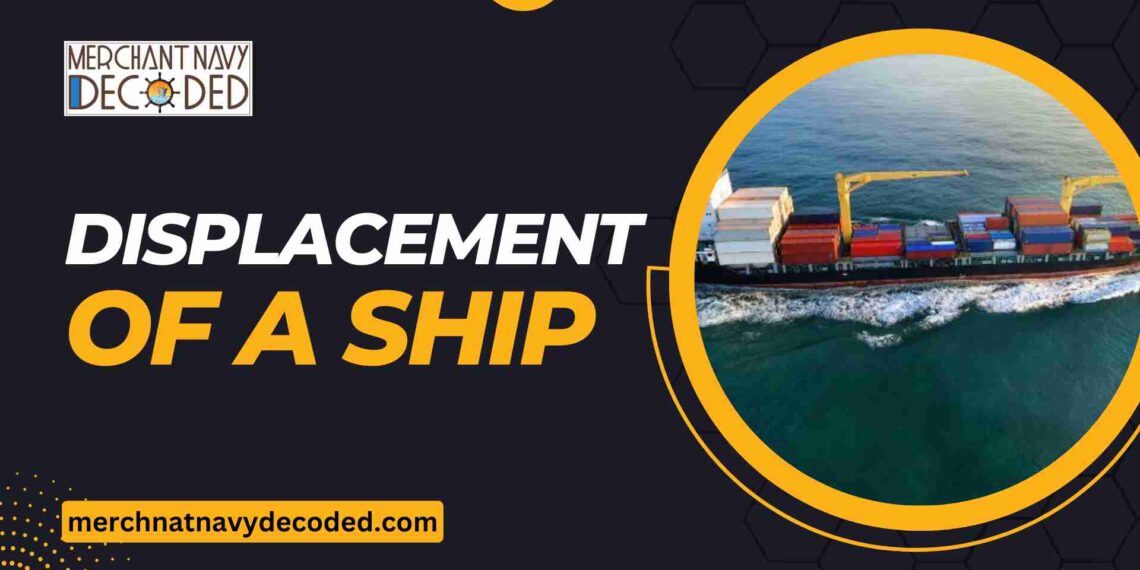Displacement of a Ship
Table of contents
1. Introduction
Displacement is commonly used to denote the mass of the ship in tonnes. Technically, it is the mass of water displaced by a ship and, when floating freely, the mass of water displaced is equal to the mass of the ship. This displacement is a crucial measurement for ships because it affects their buoyancy and stability.

To get more such information regarding the deck side of a ship like ship stability, ship construction, colregs, etc visit our DECK DREAMER package.
2. Terms Related to Displacement
2.1 Light Displacement
It is the mass of the empty ship without any cargo, fuel, lubricating oil, ballast water, fresh and feed water in tanks, consumable stores, or passengers and crew and their effects. Lightweight displacement includes the mass of equipment, machinery, accommodation, etc. Light displacement is measured in metric tonnes.

2.2 Load displacement
It is the ship’s total mass when she is floating in salt water with her summer load line at the water’s surface. It is often used to describe the overall mass or weight of the ship, including its cargo, fuel, crew, and any other items onboard. Load displacement is typically measured in metric tons (tonnes).

2.3 Present displacement
It is the sum of the light displacement of the ship and everything on board at present. It is the actual weight or mass of the ship at a specific moment in time, including all the items on board such as cargo, fuel, crew, supplies, equipment, and any other load. It represents the total weight of water the ship displaces when it is afloat.
2.4 Deadweight (DWT)
The weight of a ship is the total mass of cargo, fuel, freshwater, etc., that a ship can carry when it is floating in salt water with its summer load line at the water’s surface. Deadweight is a critical parameter for assessing a ship’s capacity to transport cargo safely and efficiently.
DWT = load displacement – light displacement

2.5 Deadweight aboard
It is the total mass of cargo, fuel, ballast, fresh water, etc., on board. It represents the sum of all the loads carried by the ship, excluding the weight of the ship’s structure itself.
DWT aboard = present displacement – light displacement
2.6 Deadweight available
It is the total mass of cargo, fuel, freshwater, etc., that can be put on the ship at present to bring her summer loadline to the water surface in salt water. It is an important parameter for ship operators, as it determines the ship’s capacity for carrying cargo and other essential items.
DWT available = load displacement – present displacement
2.7 Waterplane coefficient (Cw)
The waterplane coefficient or the coefficient of fineness of the water-plane area, is the ratio of the area of the water-plane to the area of a rectangle having the same length and the maximum breadth. The waterplane coefficient (Cw) is calculated by dividing the area of the waterplane by the area of a rectangle with the same length and breadth as the ship’s waterplane but with a constant depth equal to the ship’s draft.
Cw = Area of water-plane
L * B
Area of water-plane = L * B * Cw

2.8 Block coefficient (Cb)
Block coefficient or the coefficient of fineness of displacement, at any draft, is the ratio of the underwater volume of the ship at that draft to a rectangular box having the same extreme dimensions. Block coefficient (Cb), is calculated by dividing the underwater volume by the volume of a rectangular box having the same extreme dimensions as the tank.
Cb = Underwater volume
L * B * d
Underwater volume = L * B * d * Cb

3. Conclusion
Displacement is a fundamental concept in the merchant navy, influencing various aspects of ship operations, design, and safety. Understanding and effectively managing displacement are essential for ensuring the successful and safe operation of merchant navy vessels.
4. Frequently asked questions
Q1 What is the displacement of a ship’s stability?
Ans. When a ship is floating freely at rest, the mass of the ship is equal to the mass of the volume of water displaced by the ship.
Q2 What is the weight and displacement of a ship?
Ans. The deadweight is the difference between the displacement and the mass of an empty vessel (lightweight) at any given draught.
Q3 What is the full form of DWT?
Ans. The full form of DWT is deadweight tonnage.
Q4 What is the difference between displacement and DWT?
Ans. Displacement tonnage includes the ship’s weight while deadweight tonnage does not.
Q5 What is light displacement?
Ans. The weight of the ship excludes cargo, fuel, water, ballast, stores, passengers, and crew, but with water in boilers to steaming level.
Q6 What is the load-displacement?
Ans. Loaded displacement is the ship’s weight, including cargo, passengers, fuel, water, stores, dunnage, and other items necessary for use on a voyage.
Disclaimer :- The opinions expressed in this article belong solely to the author and may not necessarily reflect those of Merchant Navy Decoded. We cannot guarantee the accuracy of the information provided and disclaim any responsibility for it. Data and visuals used are sourced from publicly available information and may not be authenticated by any regulatory body. Reviews and comments appearing on our blogs represent the opinions of individuals and do not necessarily reflect the views of Merchant Navy Decoded. We are not responsible for any loss or damage resulting from reliance on these reviews or comments.
Reproduction, copying, sharing, or use of the article or images in any form is strictly prohibited without prior permission from both the author and Merchant Navy Decoded.



